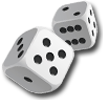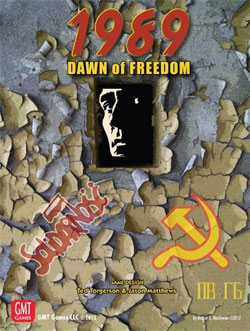



play board games
Board game reviews, strategy tips & session reports
1989 Dawn of Freedom Game Review
 Stats:
Stats:
No. of players: 2
Amount of time to play: 150 min
Age requirements: 12+
Set-up time: 15 minutes
1989: Dawn of Freedom Rules Description:
1989: Dawn of Freedom is a card-driven strategy game that depicts the fall of Communism in Eastern Europe. You play as the Communists or the Democrats either trying to hold onto power or usurp it.
1989 is a relative of Twilight Struggle. There are some similarities and also some differences. Both depict real events and put you in the middle of the conflict.
You get eight cards on your turn and play them for the Event on them or to conduct operations with the Op points equal to the number in the corner. Your two operations are to place Support or make Support Checks. If you play a card with your opponent’s Event you may use its Op points but they get the benefits from the Event. You may also use cards in Tiananmen Square.
In order to place Support you must have Support in an adjacent country. If you place Support in a country controlled by your opponent you must pay 2 Support points to add one Support. You gain control of a country by having more Support there than your opponent. The Stability number determines how much more Support you must have for control.
Support Checks remove your opponent’s Support in a country. If you roll high enough you may even get to add some of your Support. Each card you play to make a Support Check gives you two of them. You get bonuses or penalties to your roll based on the number of adjacent countries you or your opponent control.
Playing a card in Tiananmen Square does not trigger its Event. You also add the Ops Points in the card to your roll. Rolling high enough will move your marker on the track. Being ahead of your opponent in the Tiananmen Square track grants you special bonuses or one-time effects.
Each round you play 7 of your 8 cards. You start the game with the Early Year cards and add Middle Year and Late Year cards as the game progresses.
Scoring Cards are special and must be played during the round they are drawn. When you play a Scoring Card a Power Struggle occurs. Power Struggles use a separate deck of cards. There are four different suits numbered 1 to 6. If you played the Scoring Card you begin the Power Struggle by playing a card. Your opponent must play a card of the same suit as yours. Then they roll a die and if it is equal to or higher than the number on the card you played they take initiative. This goes on until someone cannot match the suit their opponent played. You roll to determine the immediate effects of losing the Power Struggle. Once these effects have been applied you score the region. The more battlefield countries you control in the region the more points you score. Before the Power Struggle begins you can choose to up the stakes. This requires you to discard cards but makes winning or losing a bigger deal. If the Communist player loses the Power Struggle the Score Card is removed from the game. The Communist player gets extra points based on the number of times the country has been scored.
The scoring track is like tug of war and once either player scores 20 VPs, they win. If this doesn’t occur the game ends after 10 rounds with a final scoring of each country. In this case the player with the most VPs wins.
Quick Review of 1989 Dawn of Freedom:
1989: Dawn of Freedom is similar to Twilight Struggle. In some ways things are more streamlined in 1989. There are also some additions that bring new elements to the game like the Power Struggle. These games feel similar but are definitely two distinct experiences.
The components for 1989 are high quality. Everything looks excellent and the rules are well organized. The board looks nice and the chits and artwork are very well designed.
I like the Power Struggle. At least part of me does. It can be random and might be too much so for some people, but I like the back and forth of it and rolling to grab initiative. But losing a couple of these because of a bad draw can really hurt your chances in the game.
I also like the streamlined actions. The Support Check action is easy to calculate and resolve. Getting two attempts per card also keeps things moving along.
Like Twilight Struggle this is a game you’ll get better at the more you play. This might mean that new players will have little hope to win against someone with experience. This might be the best way to learn the game though. Just know you’ll probably lose your first few games, but that once you get to know some of the cards, you’ll do better.
If you enjoy Twilight Struggle or are looking for an intense strategic game, you should give 1989 Dawn of Freedom a try. If you are only going to buy one of them I suggest you try both of them first. They do have a lot in common but feel and play differently. If you enjoy history or a looking for a fun two-player game this should be on your short-list too.
Score and synopsis: (Click here for an explanation of these review categories.)
Strategy 5 out of 6
Luck 4 out of 6
Player Interaction 5 of 6
Replay Value 5 out of 6
Complexity 5 out of 6
Fun 5 out of 6
Overall 5 out of 6

Leave a Reply